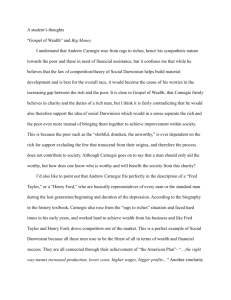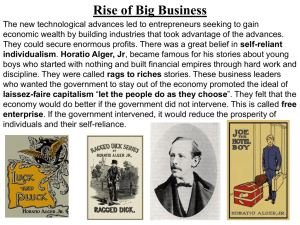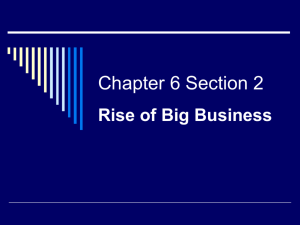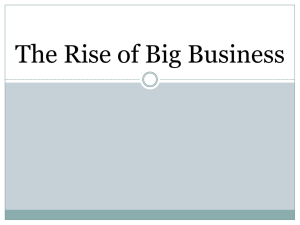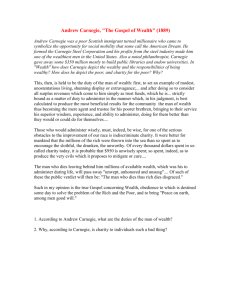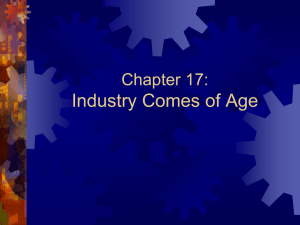Social Darwinism
advertisement
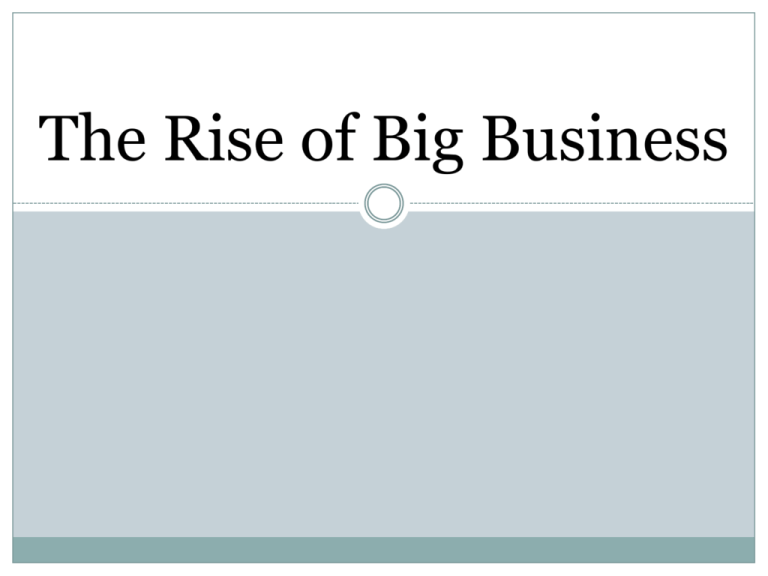
The Rise of Big Business An economic belief supported by the U.S. that opposes the government regulating business. In the late 1800’s businesses operated without much government regulation. This is known as laissez-faire economics. Laissez-faire means ‘allow to be’ or the government stays out of a person’s business in French. Laissez faire supports our economic system of capitalism Economic system characterized by private property ownership Individuals and companies compete for their own economic gain (Profit) Capitalists determine the prices of goods and services. Production and distribution are privately or corporately owned. Reinvestment of profits Supports laissez faire and the “free enterprise” system Economic system based on cooperation rather than competition Many Americans opposed capitalism and believed a socialistic economy would better suit the US because some capitalists were corrupt. Believes in government ownership of business and capital (money, natural resources) Government controls production, sets wages, prices and distributes the goods. No profit or competition. Opposite of laissez faire and capitalism MORRILL TARIFF ACT, 1862 To protect and encourage American industry, Congress passed this tariff after the South seceded from the Union. NATIONAL BANKING SYSTEM, 1863 To stimulate the economy and set up a banking system, Congress passed this act which was a significant step towards a unified, national banking system until replaced by the Federal Reserve in 1913. MORRILL ACT, 1862 To promote education, Congress provided grants of public lands to the states for support of education. “Land-grant colleges” LAND GRANTS TO RAILROADS US Govt. donated land to railroad companies to encourage growth of this mode of transportation. US Govt. donated approx. 160 million acres of land……. •Corporation: form of business consisting of a group of people authorized by law to act as a single person and with the ability to sell shares of stock to raise “capital” •Shareholders or stockholders: investors who invest their money into a corporation who each receive a share of ownership in proportion to the amount they invested •if the corporation makes a profit---than investor gets a “dividend” or a share of the profit. •Limited liability: Important aspect of a corporation is limited liability. Shareholders have the right to participate in the profits, through dividends and/or the appreciation of stock, but are not held liable for the company's debts. •“Risk is spread over the shareholders so if the company goes bankrupt, the loss is not so devastating” Key Terms to Note about Businesses-Owning FORMATION Individual or person decides to operate a business OWNERSHIP Individual CONTROL AND MANAGEMENT NET PROFITS LOSSES By owner or persons delegated by the proprietor Profits to owner Losses absorbed by owner UNLIMITED LIABILITY Key Terms to Note about Businesses-Owning FORMATION OWNERSHIP CONTROL AND MANAGEMENT NET PROFITS LOSSES By agreement between associates (partners) Jointly by two or more individuals; or by terms of partnership agreement By partners or persons they delegate Shared according to partnership agreement UNLIMITED LIABILITY Key Terms to Note about Businesses-Owning FORMATION Organized by associates and legalized through state charter OWNERSHIP Stockholders, according to number of shares CONTROL AND Through Board of Directors, elected by the stockholders (usually one MANAGEMENT vote per share of stock held) NET PROFITS AND LOSSES Dividends: to stockholders = profits Lose: only the amount invested by stockholders according to number of shares LIMITED LIABILITY Industrialization & the Rise of Big Business •Who were the Big Business Tycoons? •Andrew Carnegie – steel •Cornelius Vanderbilt – railroads •John D. Rockefeller – oil •J.P. Morgan - banking “Rags to Riches” •What does this mean? Rags to Riches? The exception, not the rule! • 95% of executives & financiers in the US around 1900 came from upper class backgrounds • Fewer than 3% started as poor immigrants or farm children • 2% of US Industrialists came from working-class origins • By 1910, the top 1% control 1/3 (33%) of all personal income. • Huge differences in the proportion of wealth eventually leads to conflict in the Gilded Age How did they “make it”? Why were their corporations so successful? What strategies did they use to make money? Were those strategies legal? Some tried to gain “monopolies”… •To gain complete control of a product or service; consumers have no other choices Some corporations formed pools or “cartels”… •Businesses making the same product work together, agree to limit production to keep prices high Trusts or Monopoly •Companies in related fields combine under the direction of a single board of trustees. •Shareholders had no say. •Outlawed today. BIGGER IS BETTER A trust or monopoly controls an entire industry •Make product cheaper •Lower prices to customer •Is this true? Other ways to increase profits include: •“Horizontal Integration” •Buying out rival businesses to gain more control of an industry •“Vertical Integration” •Gaining control of the many different businesses that make up all phases of a product’s production Vertical and Horizontal Integration Why is this a potentially dangerous business practice? Are there any businesses that do this today? Vertical Integration You control all phases of production from the raw material to the finished product Coke fields purchased by Carnegie Iron ore deposits purchased by Carnegie Steel mills purchased by Carnegie Ships purchased by Carnegie Horizontal Integration Buy out your competition until you have control of a single area of industry Railroads purchased by Carnegie Rockefeller used vertical integration to build his empire, Standard Oil •Forests •Barrel-Making Shops •Tank Cars/Railroads •Oil Wells/Pipelines •Retail Outlets Advantages Vertical Integration You are always in control of supply of the products you need In control of labor cost, land/resources Always in control of the cost Schedule your production of autos because you are in control of all factors Can you give another example of this? Other Vertical Integrations Boeing Anheiser-Busch: all grown by own producers McDonald’s: own cattle ranches Oil companies AOL Time Warner Horizontal Integration Examples – Standard Oil – Carnegie Steel – Swift & Company: meat producers – United Fruit Company: bananas – Dole Pineapple Horizontal Integration Buy out your competition until you have control of a single area of industry Modern Day Examples of Horizontal Integration Microsoft PG & E Comcast Starbucks De Beers Extortion: Forced against your will robber •Rebates: discount or refund on “freight charges” •Drawbacks / Kickbacks: Standard Oil gave certain railroads all its shipping business if it agreed to charge Standard Oil 25% to 50% less than its competitors •Buyouts: Larger corporations forced smaller businesses to sell out •Congress was “bought out” by the monopolies •Spies: Stealing your competitor's ideas Small businesses complained “monopolies” eliminated fair competition Robber Baron •Tycoons that bought out small businesses, formed monopolies & cartels, and swindled the poor Captains of Industry •Big businesses provided jobs, strengthened the economy, improved technology, and donated money to universities, charities, etc. •***Andrew Carnegie’s “Gospel of Wealth” • Philanthropy A person who organizes, operates, and assumes the risk for a business venture “Robber Barons” Business leaders built their fortunes by stealing from the public. They drained the country of its natural resources. They persuaded public officials to interpret laws in their favor. They ruthlessly drove their competitors to ruin. They paid their workers meager wages and forced them to toil under dangerous and unhealthful conditions. “Captains of Industry” The business leaders served their nation in a positive way. They increased the supply of goods by building factories. They raised productivity and expanded markets. They created jobs that enabled many Americans to buy new goods and raise their standard of living. They also created museums, libraries, and universities, many of which still serve the public today. • "The growth of large business is merely a survival of the fittest…the American Beauty rose can be produced in splendor and fragrance which brings cheer to its beholder only by sacrificing the early buds which grow up around it. This is not an evil tendency in business. It is merely the working out of the law of nature and the law of God." -John Rockefeller “Social Darwinism” • What argument is Rockefeller trying to make with his statement? • What are the main arguments being made by the ‘survival of the fittest’ Social Darwinism philosophy? • What are your thoughts? Social Darwinism ► ► ► ► ► 4,000 Americans became millionaires during the Gilded Age. Used Darwin’s Theory of Natural Selection to explain the economic evolution of human society. Wealth was the result of strong work ethic. The poor are lazy and inferior and deserved no aid. Supported laissez-faire. Herbert Spencer Social Darwinism •Social Darwinists believed that companies struggled for survival in the economic world and the government should not tamper with this natural process. •The fittest business leaders would survive and would improve society. •Belief that hard work and wealth showed God’s approval and those that were poor were lazy and naturally a lower class. 1. All living things have always competed for survival. Survival of the fittest. 2. All living things have evolved over millions of years as a result of genetic changes. 3. Some plants and animals developed traits that helped them survive. 1. Every human activity individuals compete for success. 2. The unfit or incompetent lose and the strong or competent win. 3. These winners make up a natural upper class. 4. Hard worked paid off, and lazy were inferior. Social Darwinism in America Individuals must have absolute freedom to struggle, succeed or fail. Therefore, state intervention to reward society and the economy is futile! William Graham Sumner Folkways (1906) • “The right of the working-men to combine and to form tradesunions is no less sacred than the right of the manufacturer to enter into associations and conferences with his fellows…” • “I quote from the Gospel of Wealth published twenty-five years ago. This then is held to be the duty of the man of wealth. First: to set an example of modest, unostentatious living, shunning display; to provide moderately for the legitimate wants of those dependent upon him, and after doing so, to consider all surplus revenues which come to him simply as trust funds, which he is strictly bound as a matter of duty, to administer in the manner which in his judgment is best calculated to produce the most beneficial results for the community. The man of wealth must become a trustee and agent for his poorer brethren, bringing to their service his superior wisdom, experience, and ability to administer.” -Andrew Carnegie The Gospel of Wealth: Religion in the Era of Industrialization $ Wealth no longer looked upon as bad. $ Viewed as a sign of God’s approval. $ Christian duty to accumulate wealth. Russell H. Conwell “On Wealth” $ The Anglo-Saxon race Andrew Carnegie is superior. $ “Gospel of Wealth” (1901). $ Inequality is inevitable and good. $ Wealthy should act as “trustees” for their “poorer brethren.” Gospel of Wealth • Capitalists used Social Darwinism to justify their success – Social Darwinism also coincided with the ideas of Adam Smith, especially concerning the laws of supply & demand and free markets • Carnegie wrote The Gospel of Wealth (1901) which claimed wealthy people have power but also an obligation to society • Baptist preacher Russell H. Conwell preached about “Acres of Diamonds” – everyone who wanted to be rich had the opportunity • Horatio Alger’s “Luck and Pluck” manual pushed the idea of rags-to-riches at the time to encourage everyone (think Jackson)
